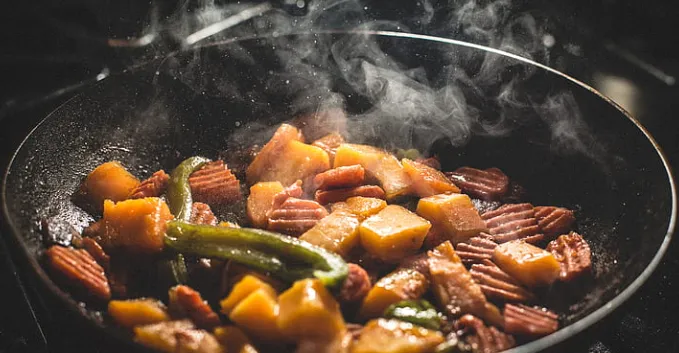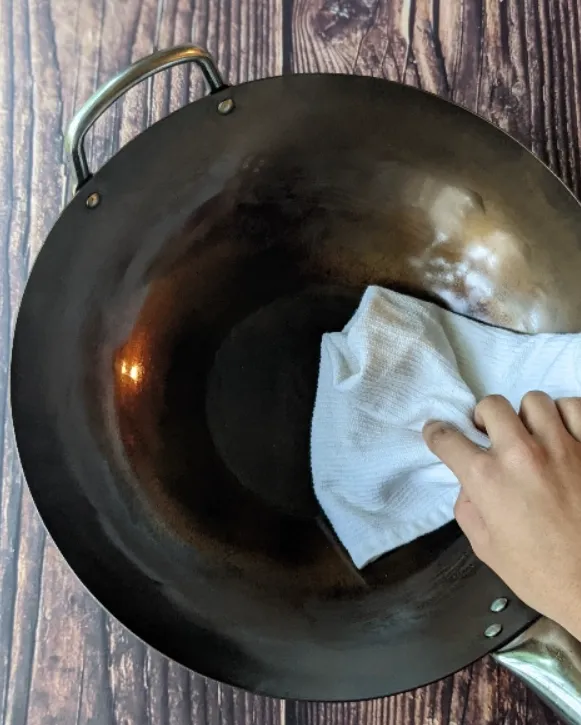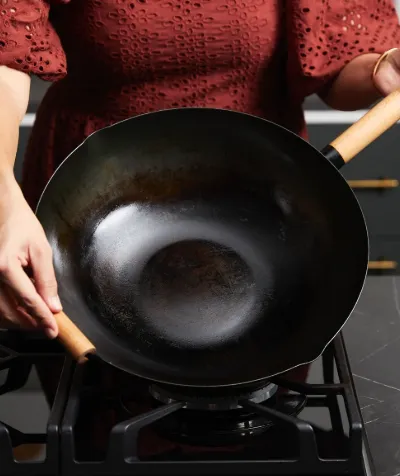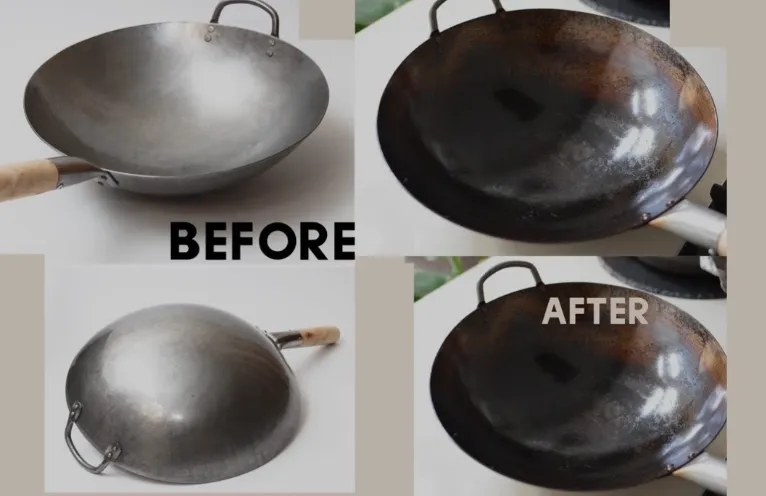Wok Materials Decoded: Carbon Steel vs. Cast Iron vs. Stainless Steel vs. Non-Stick
Wok Materials Decoded: Carbon Steel vs. Cast Iron vs. Stainless Steel vs. Non-Stick
 Material comparison: Carbon steel (recommended), cast iron, stainless steel, and non-stick woks
Material comparison: Carbon steel (recommended), cast iron, stainless steel, and non-stick woks
While form and shape are critical, the material from which a wok is made dictates its performance, maintenance, and longevity. The consumer market offers a confusing array of choices, including stainless steel and non-stick options that are fundamentally at odds with the physics and techniques of high-heat wok cooking. The primary challenge for the informed buyer is not simply choosing the best material, but filtering out the demonstrably inappropriate ones.
Material Reality: Not all wok materials are created equal. Some marketing claims directly contradict the fundamental requirements of authentic wok cooking. This guide cuts through the confusion with science-based analysis.
Carbon steel's superior performance requires proper heat sources and ventilation. Material selection works with shape and size considerations in choosing the perfect wok.
The Champion: Carbon Steel
There is an overwhelming consensus among chefs, food writers, and culinary experts: carbon steel is the best and most traditional material for a wok. It possesses the perfect combination of properties for the demands of stir-frying.
Heat Responsiveness: The Key to Control
Carbon steel is thin and an excellent conductor of heat. It heats up very quickly and, just as importantly, cools down rapidly when the heat is reduced. This responsiveness gives the cook precise temperature control, which is essential for preventing delicate ingredients like garlic and ginger from burning while ensuring others get a hard sear.
Physics Insight: Carbon steel's thermal conductivity allows heat to spread evenly across the surface while maintaining the ability to quickly adjust temperature - crucial for the rapid temperature changes required in stir-frying.
Lightweight and Maneuverable
Compared to cast iron, carbon steel is significantly lighter, making it easy to lift, tilt, and toss food—a crucial element of the stir-frying technique. This maneuverability allows for the dynamic cooking style that defines authentic wok cooking.
Technique Connection: The classic "pao" tossing motion requires a lightweight pan. Heavy materials make this essential technique impractical or impossible.
Durability and Value Proposition
Carbon steel is tough, resistant to damage, and relatively inexpensive. A high-quality carbon steel wok that can last a lifetime can often be purchased for a modest price, making it an exceptional value investment.
Seasoning Potential: The Natural Non-Stick
 Perfectly seasoned carbon steel wok displaying the coveted black patina that improves with use
Perfectly seasoned carbon steel wok displaying the coveted black patina that improves with use
This is perhaps carbon steel's greatest advantage. Through a process of seasoning, a carbon steel wok develops a natural, slick, and durable non-stick surface known as a patina. This patina is created by the polymerization of thin layers of oil and improves with every use, becoming blacker and more non-stick over time.
Science Note: The seasoning process creates a polymerized layer of fat molecules that bonds to the iron surface, forming a naturally non-stick coating that actually becomes better with use.
Some woks come pre-seasoned or with a "blued" finish, which is an initial oxidation layer that helps prevent rust and provides a head start on the seasoning process.
Carbon Steel Advantages Summary:
- Rapid heat response for precise temperature control
- Lightweight construction enabling proper technique
- Exceptional durability with lifetime potential
- Natural non-stick development that improves over time
- Outstanding value for performance delivered
The Heavyweight: Cast Iron
While some traditional Chinese woks were made of very thin cast iron, the cast iron woks commonly available in Western markets (such as those from Lodge) are thick and extremely heavy. Their primary attribute is excellent heat retention; once hot, they stay hot for a long time.
The Heat Retention Problem
For stir-frying, however, this heat retention is a fatal flaw. The inability to cool down quickly makes precise temperature control impossible. If ingredients are cooking too fast, the only recourse is to remove them from the pan, as simply lowering the flame will have little immediate effect.
Thermal Reality: Cast iron's heat retention works against the rapid temperature changes required for proper stir-frying. What's a strength for slow cooking becomes a weakness for dynamic wok techniques.
Weight and Maneuverability Issues
Furthermore, their immense weight makes the essential tossing motion of stir-frying completely impractical. A typical cast iron wok weighs 8-12 pounds empty, compared to 3-4 pounds for carbon steel.
Ergonomic Impact: The weight difference isn't just about comfort - it fundamentally changes what cooking techniques are possible. Heavy woks prevent the fluid motions that define authentic stir-frying.
Limited Applications
While cast iron woks can be used for deep-frying or slow braising (where heat retention is beneficial), they are widely considered a poor choice for the dynamic, rapid-fire nature of stir-frying.
Cast Iron Limitations for Wok Cooking:
- Excessive weight prevents proper handling
- Heat retention prevents temperature control
- Slow response to heat adjustments
- Limited technique compatibility
The Impostor: Stainless Steel
Stainless steel woks are appealing due to their shiny appearance, durability, and the fact that they are easy to clean and do not react with acidic ingredients like tomatoes or vinegar. However, they are a poor choice for high-heat stir-frying.
The Sticking Problem
The material is notoriously prone to having food stick to it, especially proteins like chicken and eggs, and starches like noodles and rice. This creates a frustrating cooking experience and prevents proper browning.
Surface Science: Stainless steel's smooth, non-porous surface lacks the micro-texture that develops in seasoned carbon steel, making it prone to sticking without adequate fat and precise temperature control.
Heat Distribution Issues
While high-end, multi-ply clad versions with an aluminum core offer better heat distribution, they still cannot develop the polymerized non-stick patina of carbon steel and lack its thermal responsiveness.
Expert Opinion
Many experts do not consider stainless steel woks to be true woks, but rather "wok-shaped pans" that cannot perform the primary function for which the tool was designed.
Professional Perspective: Restaurant chefs avoid stainless steel woks because they make authentic stir-frying techniques nearly impossible, requiring constant oil addition and careful temperature management.
The Red Flag: Non-Stick (Teflon/Ceramic)
 Damaged non-stick coating showing heat degradation and toxicity concerns
Damaged non-stick coating showing heat degradation and toxicity concerns
Non-stick woks, whether coated with PTFE (Teflon) or ceramic, should be avoided at all costs by anyone serious about wok cooking. The reason is simple and based on safety and physics.
Temperature Limitations and Safety
Authentic wok cooking demands extremely high heat, often well above 500°F (260°C), to achieve wok hei. Most non-stick coatings are not designed to withstand such temperatures. When overheated, PTFE coatings can break down and release potentially toxic fumes.
Safety Alert: PTFE breakdown can occur at temperatures as low as 464°F (240°C), well below the temperatures needed for authentic wok cooking. The fumes can be harmful to humans and fatal to pet birds.
Performance Contradictions
Beyond the safety concerns, these coatings prevent the proper browning and searing that are hallmarks of a good stir-fry. The surface is too slick to allow ingredients to be "parked" on the side of the wok, and the coating will inevitably be scratched by utensils and degrade over time, requiring the pan to be replaced.
The Marketing Paradox
The very existence of non-stick woks is a marketing paradox, offering a feature that is fundamentally incompatible with the tool's intended use.
Reality Check: Non-stick coatings solve a problem (sticking) that proper wok technique and seasoning already solve naturally, while creating new problems (temperature limitations and coating degradation).
The Complete Material Comparison
 Chart comparing wok materials across multiple performance criteria
Chart comparing wok materials across multiple performance criteria
| Metric | Carbon Steel (Recommended) | Cast Iron | Stainless Steel | Non-Stick (Not Recommended) |
|---|---|---|---|---|
| Heat Responsiveness | Excellent. Heats and cools very quickly for precise control. | Poor. Heats slowly and retains heat for a long time. | Moderate. Heats faster than cast iron but slower than carbon steel. | Poor. Base material (often aluminum) heats quickly, but coating limits max temp. |
| Heat Retention | Good. Holds heat well but releases it when needed. | Excellent. Unmatched heat retention. | Poor to Moderate. Does not retain heat as well as iron-based pans. | Poor. Does not retain heat well. |
| Weight/Maneuverability | Excellent. Lightweight and easy to toss/flip. | Poor. Very heavy and impossible to toss. | Good. Relatively lightweight but can be heavy in clad versions. | Excellent. Usually very lightweight due to aluminum base. |
| Seasoning/Non-Stick | Excellent. Develops a durable, natural non-stick patina with use. | Very Good. Seasons well but can be more maintenance-intensive. | Poor. Does not season; food is prone to sticking. | N/A. Comes with a synthetic coating. |
| Max Heat Tolerance | Very High. Ideal for the extreme heat of stir-frying. | Very High. Can withstand extreme heat. | High. Can handle high heat but prone to discoloration. | Low. Coatings degrade and can release fumes at high stir-fry temps. |
| Maintenance | Requires seasoning and careful cleaning/drying to prevent rust. | Requires seasoning and vigilant care to prevent rust. | Easy. Dishwasher safe, no seasoning required. | Easy to clean, but coating is delicate and cannot be scrubbed. |
| Price | Inexpensive. | Inexpensive to Moderate. | Moderate to Expensive. | Inexpensive to Moderate. |
| Acid Reactivity | Reactive. Acidic foods can strip seasoning if not well-established. | Reactive. Acidic foods can strip seasoning and impart a metallic taste. | Non-reactive. Excellent for use with acidic ingredients. | Non-reactive, but scratches can expose reactive aluminum base. |
| Longevity | Lifetime with proper care. | Lifetime with proper care. | Very long-lasting but may discolor. | Limited by coating degradation (2-5 years typical). |
Advanced Carbon Steel Considerations
Gauge and Thickness
 Sequential images showing wok seasoning stages and color changes
Sequential images showing wok seasoning stages and color changes
14-gauge vs. 16-gauge:
- 14-gauge (thicker): More durable, better heat retention, heavier
- 16-gauge (thinner): Lighter weight, faster heating, requires more care
Professional Choice: Most restaurant kitchens prefer 14-gauge for durability, while home cooks often prefer 16-gauge for easier handling.
Pre-Seasoned vs. Raw
Pre-seasoned advantages:
- Ready to use immediately
- Professional seasoning application
- Reduced initial maintenance
Raw steel advantages:
- Lower cost
- Custom seasoning development
- Complete control over process
Regional Manufacturing Differences
Chinese-made: Traditional construction, often hand-forged, excellent heat distribution Japanese-made: Precision manufacturing, consistent quality, premium pricing American-made: Modern production methods, readily available, good value
Making the Right Choice
For Beginners: Start with Carbon Steel
- Recommended: 14-inch, flat-bottom, pre-seasoned carbon steel
- Reasoning: Best balance of performance, forgiveness, and value
- Brands: Joyce Chen, Yosukata, Mammafong
For Experienced Cooks: Optimize for Your Style
- Traditional techniques: Round-bottom carbon steel with wok ring
- Multi-purpose cooking: Flat-bottom carbon steel, Mandarin handle
- High-volume cooking: Larger size (16-inch) carbon steel
Avoid These Materials for Serious Wok Cooking:
- Non-stick: Temperature limitations and safety concerns
- Stainless steel: Sticking problems and poor heat response
- Thick cast iron: Weight and heat retention issues
Investment Perspective
Cost Analysis
- Carbon steel wok: $30-80 for quality options
- Lifetime value: Decades of use with proper care
- Replacement cost: Essentially zero with maintenance
- Performance delivered: Professional-level results
Comparison to Alternatives
- Non-stick replacement cycle: Every 2-5 years at $50-100 each
- Stainless steel limitations: Higher cost, lower performance
- Cast iron drawbacks: Similar price, limited functionality
The Scientific Conclusion
The material choice for a wok isn't about personal preference—it's about physics, chemistry, and cooking science. Carbon steel wins on nearly every metric that matters for wok cooking:
- Thermal properties that enable proper technique
- Weight characteristics that allow dynamic handling
- Surface chemistry that develops natural non-stick properties
- Durability factors that provide lifetime value
- Safety profile that handles extreme temperatures
Bottom Line: While other materials may work for general cooking, carbon steel is specifically engineered for the unique demands of wok cooking. It's not just the best choice—it's the logical choice based on the science of how woks actually work.
Carbon steel's properties enable advanced cooking techniques and wok hei development. The choice of material fundamentally determines whether you own a true wok or simply a wok-shaped pan. Choose carbon steel, and you're investing in authentic technique, superior performance, and a lifetime of exceptional cooking.
This article is part of our comprehensive wok cooking series. Next: "Mastering Wok Techniques: From Basic Stir-Frying to Advanced Multi-Method Cooking"
Comments
Post a Comment